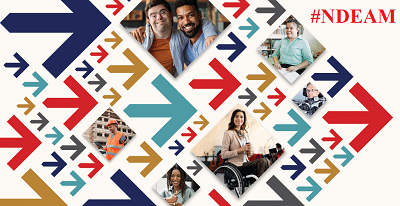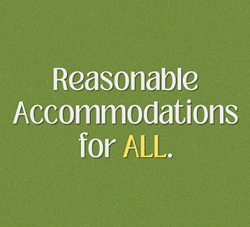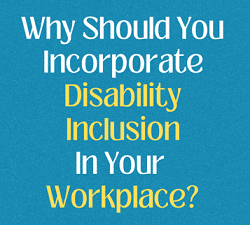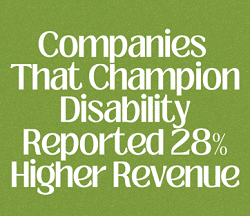
As NDEAM 2023 comes to an end there is a topic I’ve been stuck on for a while: Policy and Procedure. To some, P & P is not a topic they spend too much time thinking about. But I do. Policies and Procedures can make or break an organization. The execution of a high-level vision or directive, without solid, thoughtful P & P is nearly impossible. Good organizational rules spell out exactly what needs to be done every day to achieve a goal.
Nearly every organization in the United States, public or private, for-profit, or non-profit has some form of Disability Policies and Procedures. They often fall into two broad categories: Accessibility and Inclusion.

Accessibility policies define how people with disabilities navigate a particular space. For example, most retailers and restaurants have policies that set minimum measurements in aisles, between tables, and checkout counter heights. Those minimums are established in the Americans with Disabilities Act. But companies take what’s in the ADA and make a formal policy out of it.
In the case of our retailer and restaurant example, the employees of those companies have a procedure to ensure compliance with the minimum measurement policy. The procedure to check that policy, which is very likely referred to as the “ADA Policy”, is probably a yardstick walkthrough. An employee will literally walk around the workplace with a yardstick in front of them. If the yardstick hits something – a table, a counter, a fixture – they move it, remeasure, and keep walking. When they’re done, they sign off on a checklist and move on to the next item on their list.
Accessibility policies govern e-spaces as well. When you go to a website with an Accessibility Toolbar, there is probably a policy governing that toolbar. Even the accessibility tools in your smartphone are there because of a policy written by the company that designed it.
Accessibility policies are great. When they are well written and well executed, accessibility policies take previously restricted environments and open them up to people with disabilities. Unfortunately, these policies are mostly about compliance. At their core, these policies primarily exist to protect organizations from legal liability. And by legal liability I mean, not being sued for non-compliance to the ADA. Accessibility policies represent the bare minimum an organization can do to be open to people with disabilities.

Disability inclusion policies are about organizational culture. Inclusion policies address how to productively interact with, and manage, employees, customers, and taxpayers with disabilities. These policies are about organizational culture. Like all policies, they have elements of compliance, but cultural policies exist to drive behaviors that benefit an organization.
Some may argue that accessibility policies are also inclusion policies, and they have a point. But a physical environment can be accessible to a person with disabilities without being inclusive of them. For example, businesses that are open to the public, like retailers and restaurants, may have well maintained curb cuts, wide aisles, and accessible rest rooms. But if the people who work in those places have no training on how to interact with their employees, customers, and taxpayers with disabilities, it’s not inclusive – only accessible.
Yes, compliance focuses on behavior. But adherence to the ADA in workspace is primarily about the physical environment. Inclusion policies in the workplace are about the personal environment.
If you are wondering where your disability related policies and procedures fall, consider this:
If your disability policies focus on some of the examples listed below, those are Accessibility policies.
- Using a yardstick to measure aisle clearances and counter and table heights.
- Maintaining curb cuts in sidewalks.
- Accessibility Toolbars on websites.
These are designed to ensure that people with disabilities can safely navigate an environment (physical or electronic) with minimum effort. Accessibility policies are about the place.
If your disability policies address interpersonal interactions with people with disabilities, they are Inclusion polices. Some examples are:
- Disability etiquette training for all employees.
- Inclusive interviewing guides for HR and Hiring Managers.
- Reasonable accommodation guidelines.
These policies guide the crucial social interactions in the workplace. They help employees with disabilities to be integrated into the team and make customers and taxpayers with disabilities feel included in the social environment. Inclusion policies are about the people.
For any organization, public or private, for-profit, or non-profit, Accessibility is the baseline. It’s the minimum limit required to do business. But Inclusion has no limits.

In this period of historically low unemployment, organizations that can attract and retain employees with disabilities can establish a competitive edge over the ones who can’t. Businesses that understand that people with disabilities are their customers too, can gain that same edge over those who can’t. But to gain (and keep) that edge, smart, thoughtful policies that address accessibility and inclusion are needed.
Are you interested in learning more?
If you would like me to come speak to your civic organization, association, business, leadership team, hiring managers or general staff, please contact me by email at jonathan.taylor@dfa.arkansas.gov. Before joining the Council staff, I was a retail manager with extensive on-the-job experience in inclusive hiring, leading managers and human resource personnel, and supporting individuals with disabilities to gain employment and remain employed. I can share my real-world, usable tips and tools with you and your team!




